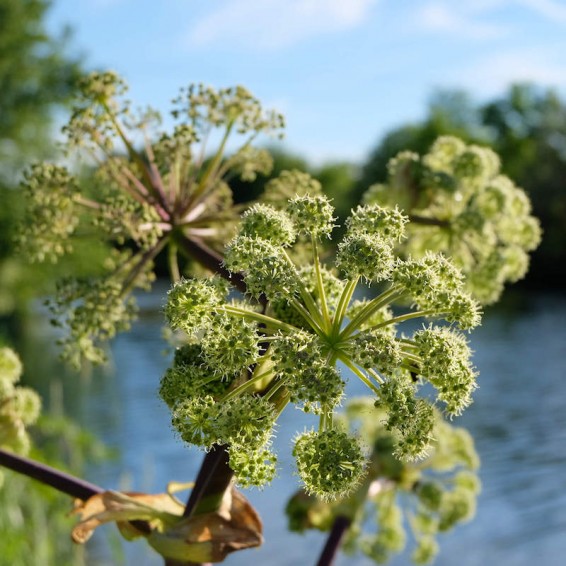Angelica Seeds
- HOW TO GROW
- FAST FACTS
- REVIEWS
HOW TO GROW
Sowing: To break its dormancy this seed needs a period of cold moisture, a period of warm moisture, followed by another period of cold moisture. Mix the seed with moist sand and store it in the refrigerator for 60 days, then move it to a 70-75 degrees F location for 30-60 days, followed by another 30-60 day period in the refrigerator before planting. To accomplish this naturally, simply plant the seed in late fall and wait until the second spring after planting for germination.To start the treated seed indoors, plant Angelica seeds in trays just under the surface of the soil, since they need light to germinate. The germination rate of this seed is naturally low, and the seeds will be slow to sprout. The seedlings should be transplanted while they are small, since larger plants do not tolerate transplanting well.
Growing: This plant grows best in full sun or dappled shade and moist soil, preferably near water. It reaches its full size in its second year of growth, and often doesn't bloom until its third year. Though the foliage dies back in winter, it survives cold weather well. If grown for its roots, the quality and size will be improved by pruning off the flower heads; this also lengthens the life of the plant, since it dies after producing seed. This plant reproduces itself by side shoots, but does not spread aggressively. Angelica attracts butterflies, especially the short-tailed swallowtail.
Harvesting: All parts of angelica plant are edible, and can be used for culinary or medicinal purposes.The roots are at their best in the autumn of the first year, while the stems and leaves are at their best in the spring of the second year. The seeds can be used when they have ripened. When harvesting angelica in the wild, keep in mind that it strongly resembles water hemlock, a very deadly poisonous plant.
Seed Saving: The Angelica seeds will turn from green to yellow when mature; remove the seed heads and spread them out to dry away from direct sunlight. Rub them lightly to separate the seed from the stems. Plant Angelica seeds as soon as possible, or store them in the refrigerator for up to a year.
FAST FACTS
Common Names: Purplestem Angelica, Darkpurple Alexanders, Wild Masterwort
Latin Name: Angelica atropurpurea
Species Origin: US Native Wildflower
Type: Native Wildflowers
Life Cycle: Perennial
USDA Zones: 1, 2, 3, 4, 5, 6
US Regions: Midwest, Northern, Northeast
Seeds per Ounce: 5,900
Stratification: Cold/Wet for 12 Weeks, then Warm/Wet for 12 Weeks - Repeat
Germination Ease: Stratify 24 Weeks
Sunlight: Full Sun, Part Sun
Height: 80 Inches
Color: Green
Bloom Season: Blooms Late Spring
huge addition to garden
These are LARGE plants and take a little work (follow instructions!) to grow. They do naturalize if left alone in garden. I have them mixed with milk weed.
Cold scarification
It's my fault for not buying and sowing these seeds ahead but would be nice if these seed had gone through cold scarification before purchase. Many people don't know about this requirement and will sow in the spring without cold scarification and get poor or maybe no results.
You are absolutely correct that if they are not planted in the fall, they will need to have their dormancy broken. You will find instructions are on the back of the packet on how to stratify.
DESCRIPTION

HOW TO GROW
Sowing: To break its dormancy this seed needs a period of cold moisture, a period of warm moisture, followed by another period of cold moisture. Mix the seed with moist sand and store it in the refrigerator for 60 days, then move it to a 70-75 degrees F location for 30-60 days, followed by another 30-60 day period in the refrigerator before planting. To accomplish this naturally, simply plant the seed in late fall and wait until the second spring after planting for germination.To start the treated seed indoors, plant Angelica seeds in trays just under the surface of the soil, since they need light to germinate. The germination rate of this seed is naturally low, and the seeds will be slow to sprout. The seedlings should be transplanted while they are small, since larger plants do not tolerate transplanting well.
Growing: This plant grows best in full sun or dappled shade and moist soil, preferably near water. It reaches its full size in its second year of growth, and often doesn't bloom until its third year. Though the foliage dies back in winter, it survives cold weather well. If grown for its roots, the quality and size will be improved by pruning off the flower heads; this also lengthens the life of the plant, since it dies after producing seed. This plant reproduces itself by side shoots, but does not spread aggressively. Angelica attracts butterflies, especially the short-tailed swallowtail.
Harvesting: All parts of angelica plant are edible, and can be used for culinary or medicinal purposes.The roots are at their best in the autumn of the first year, while the stems and leaves are at their best in the spring of the second year. The seeds can be used when they have ripened. When harvesting angelica in the wild, keep in mind that it strongly resembles water hemlock, a very deadly poisonous plant.
Seed Saving: The Angelica seeds will turn from green to yellow when mature; remove the seed heads and spread them out to dry away from direct sunlight. Rub them lightly to separate the seed from the stems. Plant Angelica seeds as soon as possible, or store them in the refrigerator for up to a year.
FAST FACTS
Common Names: Purplestem Angelica, Darkpurple Alexanders, Wild Masterwort
Latin Name: Angelica atropurpurea
Species Origin: US Native Wildflower
Type: Native Wildflowers
Life Cycle: Perennial
USDA Zones: 1, 2, 3, 4, 5, 6
US Regions: Midwest, Northern, Northeast
Seeds per Ounce: 5,900
Stratification: Cold/Wet for 12 Weeks, then Warm/Wet for 12 Weeks - Repeat
Germination Ease: Stratify 24 Weeks
Sunlight: Full Sun, Part Sun
Height: 80 Inches
Color: Green
Bloom Season: Blooms Late Spring
Reviews
Review
huge addition to garden
These are LARGE plants and take a little work (follow instructions!) to grow. They do naturalize if left alone in garden. I have them mixed with milk weed.
Review
Cold scarification
It's my fault for not buying and sowing these seeds ahead but would be nice if these seed had gone through cold scarification before purchase. Many people don't know about this requirement and will sow in the spring without cold scarification and get poor or maybe no results.
You are absolutely correct that if they are not planted in the fall, they will need to have their dormancy broken. You will find instructions are on the back of the packet on how to stratify.




